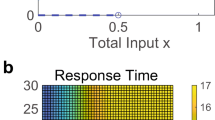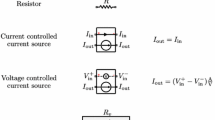Abstract
A dynamic, strong winner-take-all model is presented. It is based on a limited integrator that is fed by potential differences between feedback from a single interneuron and the input value. The model does not require a special nonlinear function in the forward path. In equilibrium state, a single winner neuron transmits its input value to the output without change. For a two-neuron system the behaviour is shown graphically. Equilibrium states are determined for different types of input vectors.
Similar content being viewed by others
References
H.B. Barlow. Cerebral cortex as model builder. In D. Rose and V.G. Dobson, editors,Models of the Visual Cortex, ch. 4, pp. 37–45. John Wiley & Sons Ltd, 1985.
R. Coultrip, R. Granger, and G. Lynch. A cortical model of winner-take-all competition via lateral inhibition,Neural Networks, vol. 5, pp. 47–54, 1992.
B. Ermentrout. Complex dynamics in winner-take-all neural nets with slow inhibition,Neural Networks, vol. 5, pp. 415–431, 1992.
T. Kohonen. Physiological interpretation of the self-organizing map algorithm,Neural Networks, vol. 6, pp. 895–905, 1993.
S. Kaski, T. Kohonen. Winner-take-all networks for physiological models of competitive learning,Neural Networks, vol. 7, pp. 973–984, 1994.
Author information
Authors and Affiliations
Rights and permissions
About this article
Cite this article
Möller, R. A strong winner-take-all model based on integration of potential differences. Neural Process Lett 2, 1–3 (1995). https://doi.org/10.1007/BF02332157
Issue Date:
DOI: https://doi.org/10.1007/BF02332157




